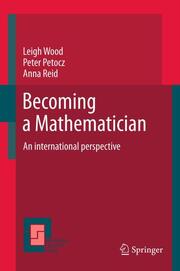-
Zusatztext
-
This book considers the views of participants in the process of becoming a mathematician, that is, the students and the graduates. This book investigates the people who carry out mathematics rather than the topics of mathematics. Learning is about change in a person, the development of an identity and ways of interacting with the world. It investigates more generally the development of mathematical scientists for a variety of workplaces, and includes the experiences of those who were not successful in the transition to the workplace as mathematicians. The research presented is based on interviews, observations and surveys of students and graduates as they are finding their identity as a mathematician. The book contains material from the research carried out in South Africa, Northern Ireland, Canada and Brunei as well as Australia.
-
-
Kurztext
-
Mathematicians are everywhere and nowhere: although they play key roles in industry and research, business and science, the people who use the ideas and tools of the mathematics are often invisible and difficult to identify. This leads to a lack of clarity for students who are studying the mathematical sciences in their transition to professional life. Becoming a Mathematician considers the process of developing a mathematical identity and becoming a mathematician from the point of view of the participants in the process - students and recent graduates. It focuses on the people who do mathematics rather than on the topics of mathematics. It investigates the development of mathematical scientists for a variety of workplaces, and incorporates the experiences of those who were unsuccessful as well as those who were successful in the transition to the profession. The research presented is based on interviews, observations and surveys of students and graduates as they develop their identity as mathematicians, carried out over a decade in Australia and a diverse range of countries.
-
-
Autorenportrait
- InhaltsangabeChapter 1: Introduction: How does a person become a mathematician?.- Chapter 2: How do mathematics students think of mathematics? - a first look.- Chapter 3: How do mathematics students go about learning mathematics? - a first look.- Chapter 4: What do mathematics students say about mathematics internationally?.- Chapter 5: How can we track our students' progress towards becoming mathematicians?.- Chapter 6: What is the contribution of mathematics to graduates' professional working life?.- Chapter 7: What is the role of communication in mathematics graduates' transition to professional work?.- Chapter 8: What university curriculum best helps students to become mathematicians?.- Chapter 9: How can professional development contribute to university mathematics teaching?.- Chapter 10: Conclusion: Becoming a mathematician - revisited.- References.- Appendix 1. Short form of conceptions of mathematics survey.- Appendix 2. Mathematical communication outcomes.- Appendix 3. Australian professional development framework.
Detailansicht
Becoming a Mathematician
An international perspective, Mathematics Education Library 56
ISBN/EAN: 9789400729834
Umbreit-Nr.: 1333831
Sprache:
Englisch
Umfang: viii, 188 S., 5 s/w Illustr.
Format in cm:
Einband:
gebundenes Buch
Erschienen am 15.02.2012
Auflage: 1/2012


